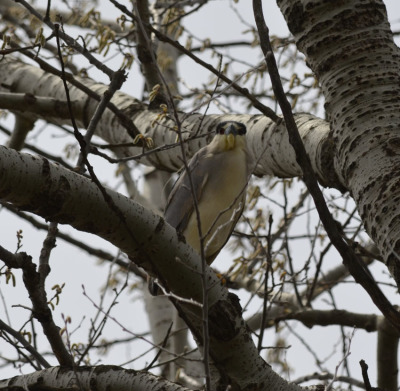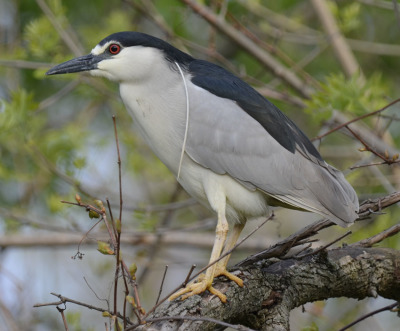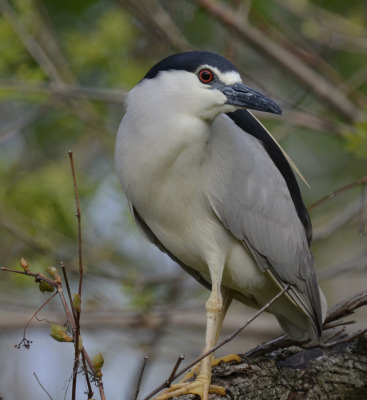When I think of herons, I usually think of a Great Blue Heron stalking slowly through the water as a few wisps of grey mist curl around its legs. As the sun burns off the morning fog, I often see herons perched on semi-submerged logs or docks fishing for frogs, crayfish and minnows along the shore. I’m not particularly used to seeing herons perching in trees especially in the bright morning sunshine.
Apparently, I’m not the only one who thinks herons belong in the water in daytime. I met another morning rambler at the Rattray watching a heron which had just landed in a small tree near the boardwalk. I had seen the impressive sweep of dark grey and white wings as it swept in to a landing and was pleased the bird had settled where we could see it. This watcher was puzzled about why the heron had landed in a tree.
As I suspected from the colouring and location, it was a Black Crowned Night Heron. They are a fairly common bird in the Toronto area although they aren’t particularly common in the Rattray Marsh.

Night Herons have reasonably long necks when they stretch them out.
I commented to the other person that Night Herons like these usually hunt at dawn, dusk and at night, and then rest during the sunny part of the day. They often roost is trees and use the leaves to help conceal themselves from predators and nuisances. The place this bird had landed, though, was not one of the usual roosts. Sure enough, it flew a few minutes later.
In the spring I’ve seen some roosting in odd places before. One was in a mostly dead poplar tree, not really close to any water but not far if it flew to the Lake, at Lakeside Park in Mississauga. Like this bird, that one left later in the day and did not return.

It took a minute to recognize this Night Heron at Lakeside in 2014. Between the bird perching in a poplar and my looking at it bill-on, the heron didn’t look familiar at all!
Another Reason for Herons to Perch in Trees
Many herons nest in trees including Great Blue Herons and Black Crowned Night Herons. Great Blues may nest in spaced out groups especially if there are several drowned trees in a marshy area. Black Crowneds will share a tree or sometimes will build in cattail clumps. Great Blues have been known to fly quite a distance from their nests to feed with different birds heading off in different directions. Sometimes the location of the nesting area can be found by watching for herons returning in the evening.
Do Black Crowned Night Herons Migrate?
Black Crowned Night Herons have managed to successfully over-winter in the Toronto area. Due to thermal pollution there are always some areas of open water in Toronto, even when it’s -30C. Many of the herons, though, migrate south and return in the spring. The bird I saw this morning may have been a migrant passing through.
Last fall, a Yellow Crowned Night Heron juvenile joined a group of young Black Crowned Night Heron’s a Colonel Sam Smith Park. Hopefully, it moved south with them before freeze up because it was not reported during the winter.
I quite enjoyed meeting this heron unexpectedly. It made my rather cold morning walk more memorable.
Related Reading
- A Late Autumn Encounter with Hoodies in Humber Bay Park
- Least Bittern Stalks Colonel Sam Smith
- What Large White Wading Bird is Stalking through the Marshes of Southern Ontario?
Join In
Have you encountered a heron with a “punk rock” hairdo? Was it hunting along the shoreline or perching sleepily on a branch? Please share your sighting with a comment.



Hi, just thought I’d share some photos from May 2018. I’ve never seen these birds before. It was so exciting to have seen them. We were at the Renaissance Faire in Southern CA, by the 605 and 210 freeways. I have photos if you want to see them, I tried pasting them in here, but couldn’t
Sorry there is no way to post photos here. You may want to add a report to eBird.org where they love to get the photos!
I saw a large bird that looked like a kingfisher only 10 times the size hunting in a pond up the road from my place. Got some great pics. Wasn’t sure what it was. Then I saw a female of the same colour & size in the trees in my back yard along the creek. I didn’t get a good pic of her last year but just the other day I saw her again & was able to get a few pics. Can’t wait to see how they turn out. I was researching what they were & found this site. Most what I was reading didn’t include North America so I was happy to see this about Toronto. I live in Trenton about 2 hours away. Before this I have only seen blue herons before.
I hope you’ve solved your mystery bird. If you did get a good photo, you can use a free website called inaturalist.org to share your photo. In many cases, the volunteers can identify it. Either way, it sounds like a very interesting pair of birds to watch so close to home!